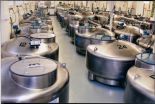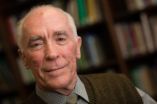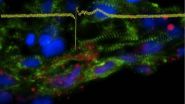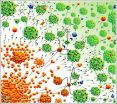(Press-News.org) Chapel Hill, N.C. – Biobanks are organizations that collect, store and share human specimens (e.g., blood, solid tissues, hair) for research purposes. The rise of the human genome project and of large-scale genetics studies have spurred a dramatic increase in the number of biobanks in the last decade, increasing their importance in biomedical research.
But until now, biobanks in the U.S. have never been studied systematically, leaving few clear details as to how they are run or the policies and practices they use in managing their work.
A new study from the University of North Carolina published January 25, 2013 in the journal Genome Medicine reveals the huge diversity of U.S. biobanks and also raises questions about the best way to manage and govern them.
"Biobanks are increasingly important to scientific advances, but our decentralized, fragmented research enterprise system in the U.S. has encouraged their development without necessarily providing them with the tools to survive," says study leader Gail Henderson, PhD, professor and chair of social medicine at the University of North Carolina. She also heads UNC's Center for Genomics and Society.
Henderson and colleagues from UNC decided to address this paucity of information by inviting more than 600 biobanks in the U.S. to participate in an online survey. These included private and public, commercial and noncommercial, and many biobanks affiliated with hospitals and academia. Representatives of 456 U.S. biobanks (72 percent of the list invited) participated in the survey.
Among the main findings is their great diversity. "They get established for a variety of reasons; some accidental, some intentional. They vary in size, in when they were established, how formal they are as organizations, what kinds of specimens they hold, who pays for them, and where those specimens come from," Henderson notes.
In the survey, just over half (53 percent) listed research on a particular disease, such as cancer, as the most important reason for establishment. Twenty-nine percent listed research generally. Other reasons included response to a gift or grant, and "intent to centralize, integrate, or harmonize" older specimen collections.
The size of U.S. biobank collections varies, in number of specimens (from tens to millions) and in the types and where they come from – individuals, clinics, hospitals, public health programs, and research studies.
Henderson also points out that only a small minority are commercial businesses. "So, not surprisingly, most biobanks do not perceive being in a competitive market. But the majority are quite worried about funding, and many are concerned that the specimens they collect aren't being adequately utilized."
"Researchers and people whose specimens are being held need to be concerned that we don't have a system that is as efficient and effective as it could be," Henderson adds. "If you collect specimens but don't use them, this is a failure to deliver on the promise of advancing translational research, and thus an ethical as well as technical concern."
Biobanks, like the researchers who depend on their services and specimens, need guidance informed by knowledge of their practices and challenges, the authors state. Required are policies "as nuanced as the biobanks themselves," whether these policies address issues of privacy or identity protection, or advancement of research goals.
"Given the diversity in biobank organizational characteristics identified in our survey, it's likely that management and governance policies will have to be tailored to fit the particular context. One-size policies will not fit all," says Henderson.
INFORMATION:
UNC study coauthors are R. Jean Cadigan, Teresa P. Edwards, Ian Conlon, Anders G. Nelson, James P. Evans, Arlene M. Davis, Catherine Zimmer, and Bryan J. Weiner.
Support for the research comes from the National Human Genome Research Institute (NHGRI), a component of the National Institutes of Health, and the UNC Clinical & Translational Science Award (CTSA).
Study of human specimen collections in the US offers first look at their huge diversity
2013-01-28
ELSE PRESS RELEASES FROM THIS DATE:
Discovering the missing 'LINC' to deafness
2013-01-28
Tel Aviv — Because half of all instances of hearing loss are linked to genetic mutations, advanced gene research is an invaluable tool for uncovering causes of deafness — and one of the biggest hopes for the development of new therapies. Now Prof. Karen Avraham of the Sackler Faculty of Medicine at Tel Aviv University has discovered a significant mutation in a LINC family protein — part of the cells of the inner ear — that could lead to new treatments for hearing disorders.
Her team of researchers, including Dr. Henning Horn and Profs. Colin Stewart and Brian Burke of ...
With hot air treatment, bacteria fly the coop
2013-01-28
This press release is available in Spanish.Poultry producers can reduce bacterial cross-contamination in poultry cages by treating the cages with forced air that's been heated to 122 degrees Fahrenheit, according to a study by U.S. Department of Agriculture (USDA) scientists.
While being transported in coops on trucks, poultry that have bacteria such as Campylobacter can contaminate, through their feces, other poultry that are free of pathogens. Those disease-causing bacteria can then be passed on to the next group of birds during the next trip, and so forth, unless ...
Islet transplant may slow progression of atherosclerosis
2013-01-28
Minimally invasive islet transplantation for patients with type 1 diabetes achieves insulin independence and reverses the progression of atherosclerosis in the first few years after transplant, according to a University of Illinois at Chicago study.
The research is published in the February issue of the journal Diabetes Care and is available online.
Patients with diabetes, particularly women, have a substantial increased risk of dying from ischemic heart disease, according to previous research. However, future cardiac events may be prevented with intensive glycemic ...
Central Valley irrigation intensifies rainfall, storms across the Southwest
2013-01-28
Irvine, Calif., Jan. 28, 2013 – Agricultural irrigation in California's Central Valley doubles the amount of water vapor pumped into the atmosphere, ratcheting up rainfall and powerful monsoons across the interior Southwest, according to a new study by UC Irvine scientists.
Moisture on the vast farm fields evaporates, is blown over the Sierra Nevada and dumps 15 percent more than average summer rain in numerous other states. Runoff to the Colorado River increases by 28 percent, and the Four Corners region experiences a 56 percent boost in runoff. While the additional ...
Safeguards needed for tissue donors
2013-01-28
Donors to biobanks – vast collections of human tissue samples that scientists hope will lead to new treatments for diseases – have a right to basic information about how their donations may be used, a Michigan State University ethicist argues in a new paper.
The idea behind biobanks is that a repository with hundreds of thousands of samples, each linked to medical records and other health information, can yield discoveries smaller data sets can't match. Once samples are collected, researchers in many fields can use the data repeatedly.
"More and larger biobanks are ...
New LGBT Health journal launching in 2013
2013-01-28
New Rochelle, NY, January 28, 2013—Over 4 million adults in the United States identify as gay, lesbian, or bisexual and approximately 700,000 identify as transgender. An NIH-sponsored investigation by the Institute of Medicine (IOM) concluded that the health status and healthcare needs of this sizable population are poorly understood and likely inadequately met. A journal is urgently needed to support, promote, and address the unique healthcare needs of each population that comprises the LGBT community, in the United States and worldwide. LGBT Health, a new peer-reviewed ...
Best friends influence when teenagers have first drink
2013-01-28
Chances are the only thing you remember about your first swig of alcohol is how bad the stuff tasted. What you didn't know is the person who gave you that first drink and when you had it says a lot about your predisposition to imbibe later in life.
A national study by a University of Iowa-led team has found that adolescents who get their first drink from a friend are more likely to drink sooner in life, which past studies show makes them more prone to abusing alcohol when they get older. The finding is designed to help specialists predict when adolescents are likely to ...
Patients' own skin cells are transformed into heart cells to create 'disease in a dish'
2013-01-28
LA JOLLA, Calif., January 27, 2013 – Most patients with an inherited heart condition known as arrhythmogenic right ventricular dysplasia/cardiomyopathy (ARVD/C) don't know they have a problem until they're in their early 20s. The lack of symptoms at younger ages makes it very difficult for researchers to study how ARVD/C evolves or to develop treatments. A new stem cell-based technology created by 2012 Nobel Prize winner Shinya Yamanaka, M.D., Ph.D., helps solve this problem. With this technology, researchers can generate heart muscle cells from a patient's own skin cells. ...
Demagnetization by rapid spin transport
2013-01-28
For purposes of their research, the scientists irradiated two separate layered systems with ultrashort laser pulses on the order of just one hundred femtoseconds (10-15 s). One sample consisted essentially of a single thin layer of ferromagnetic nickel. By contrast, a second sample of this same nickel material was coated with a non-magnetic layer of gold. Only a mere 30 nanometers (10-9 m) thick, the gold layer swallowed up the lion's share of the laser light so that barely any light ended up reaching the nickel layer. In spite of this, the nickel layer's magnetization ...
Accelerating neutral atoms on a table top
2013-01-28
Charged particle accelerators have become crucially important to modern day life, be it in health care for cancer treatment or for answering important fundamental scientific questions like the existence of the HIGGS boson, the so called 'God particle'. In a simple picture, charged particles like electrons and protons are accelerated between two end plates across which an electrical voltage is applied. High energies need high voltages (millions and billions of volts) and long acceleration paths in giant sized machines – for instance the trillion volt machine called the 'large ...




